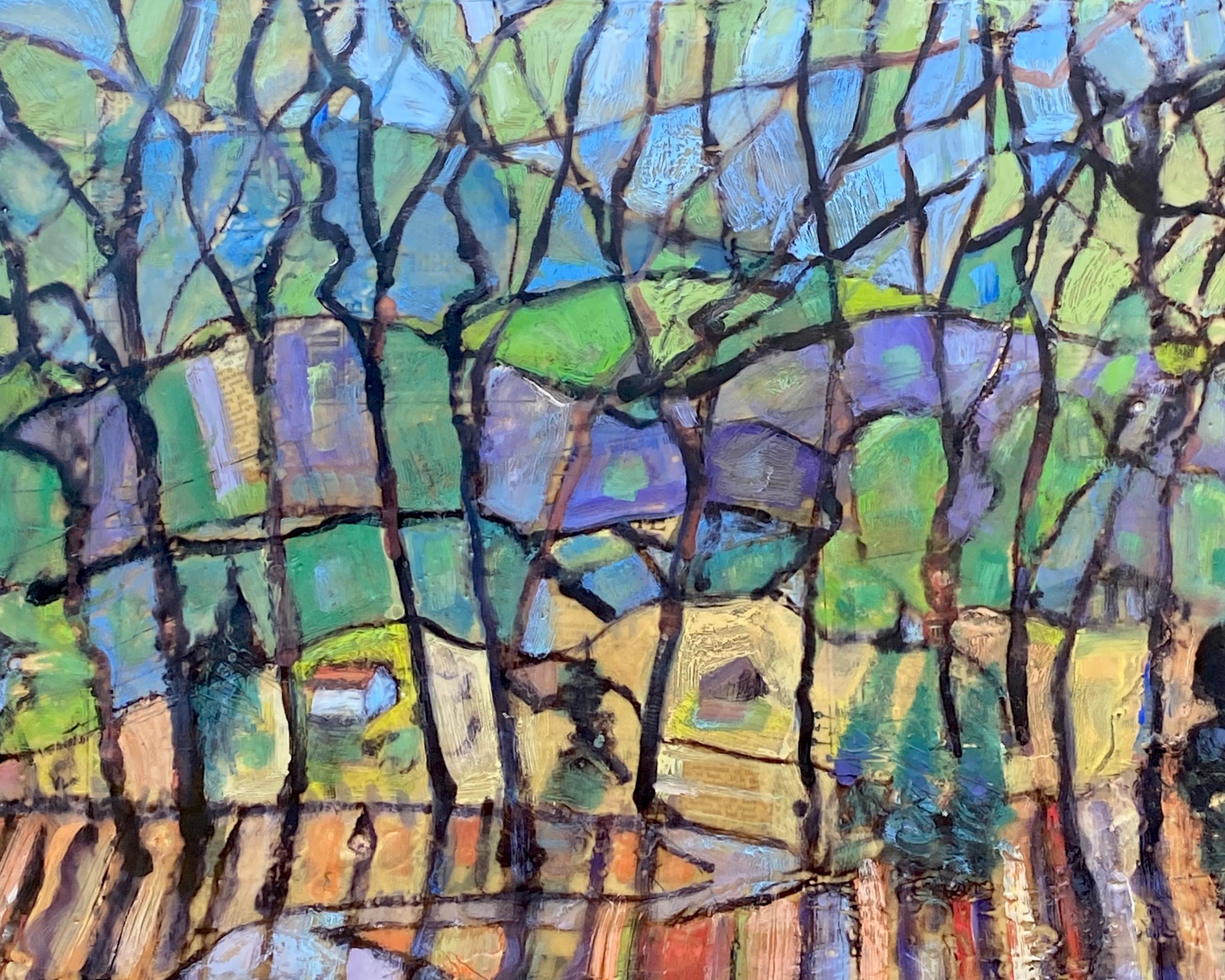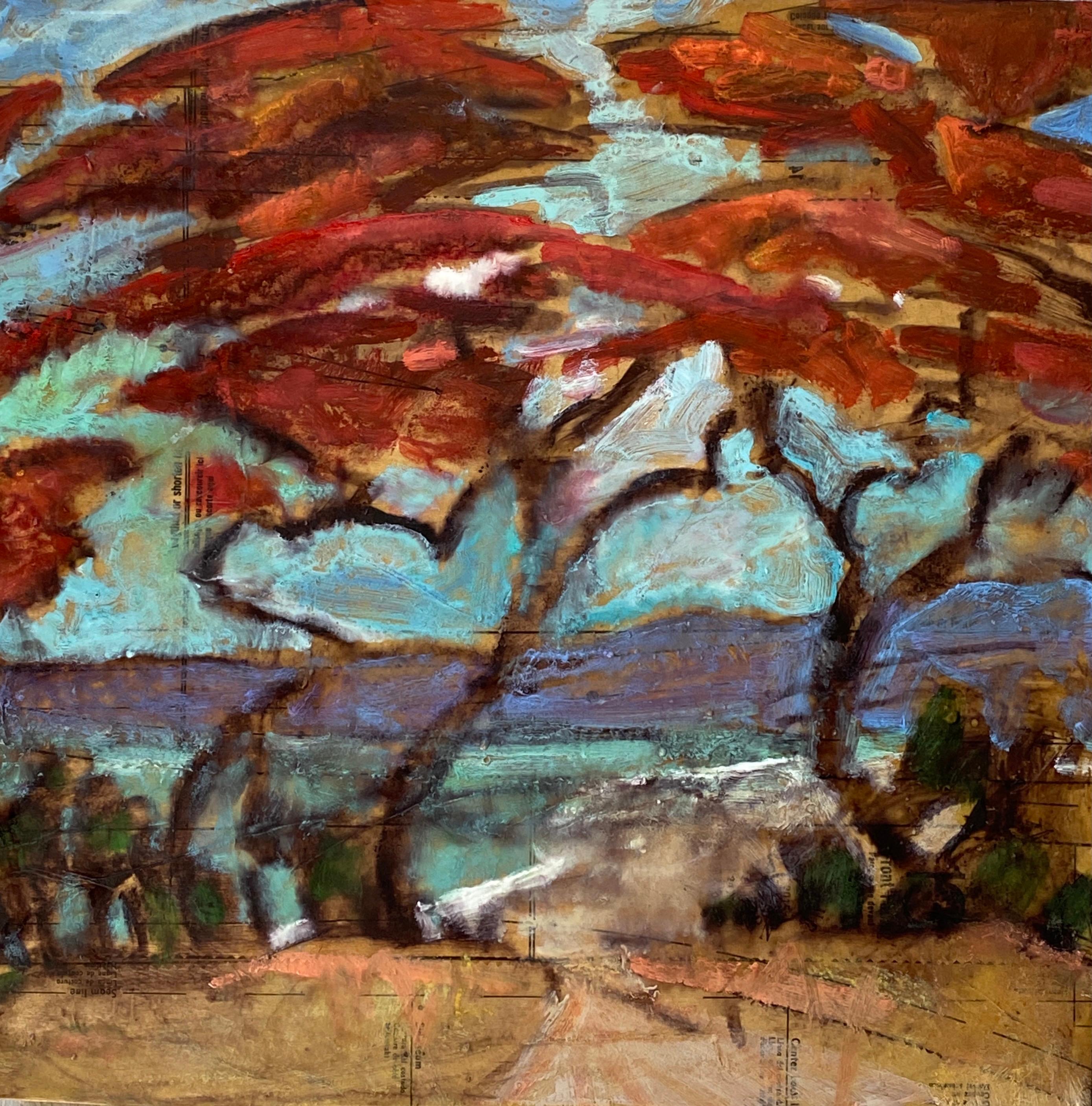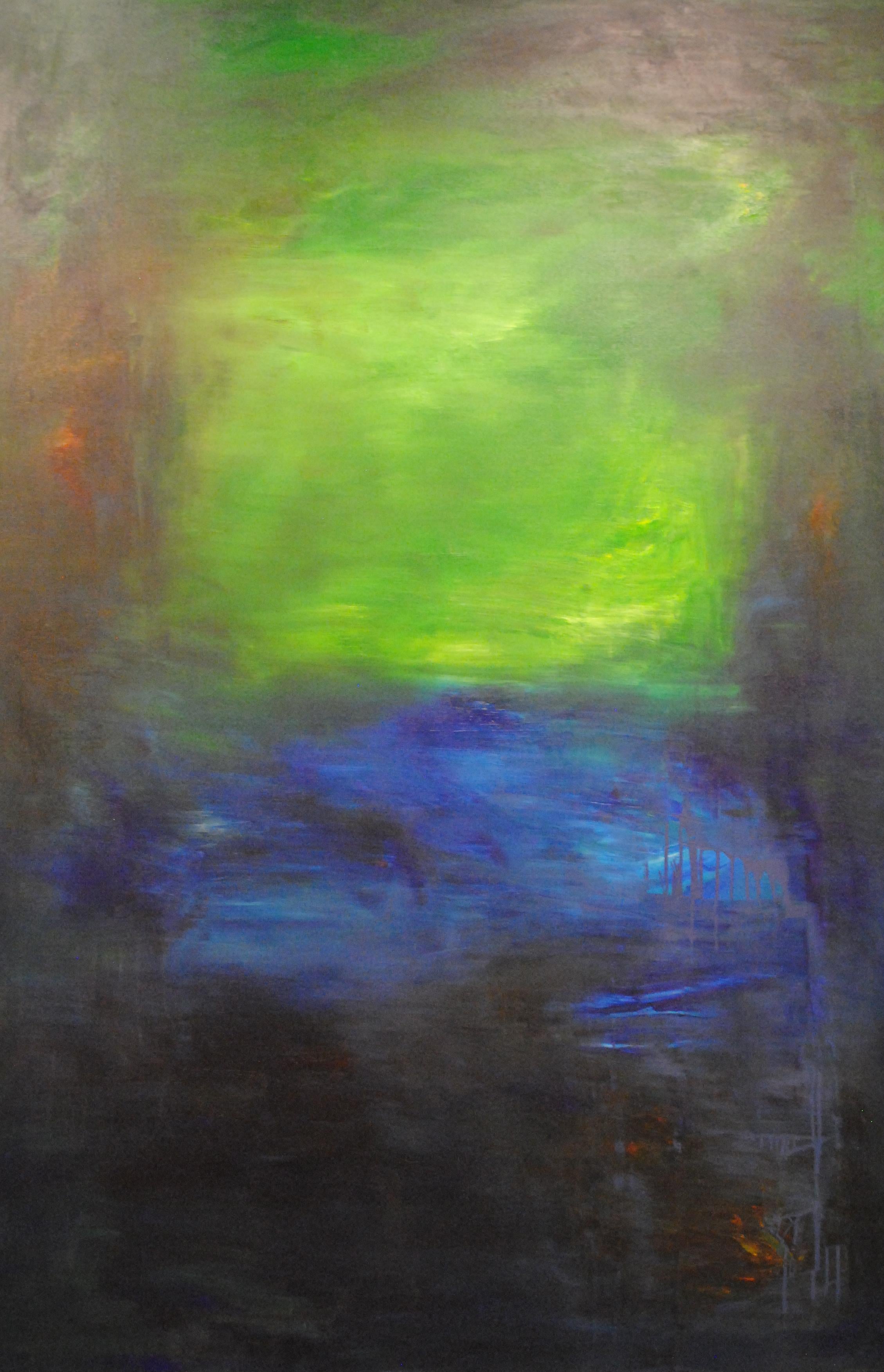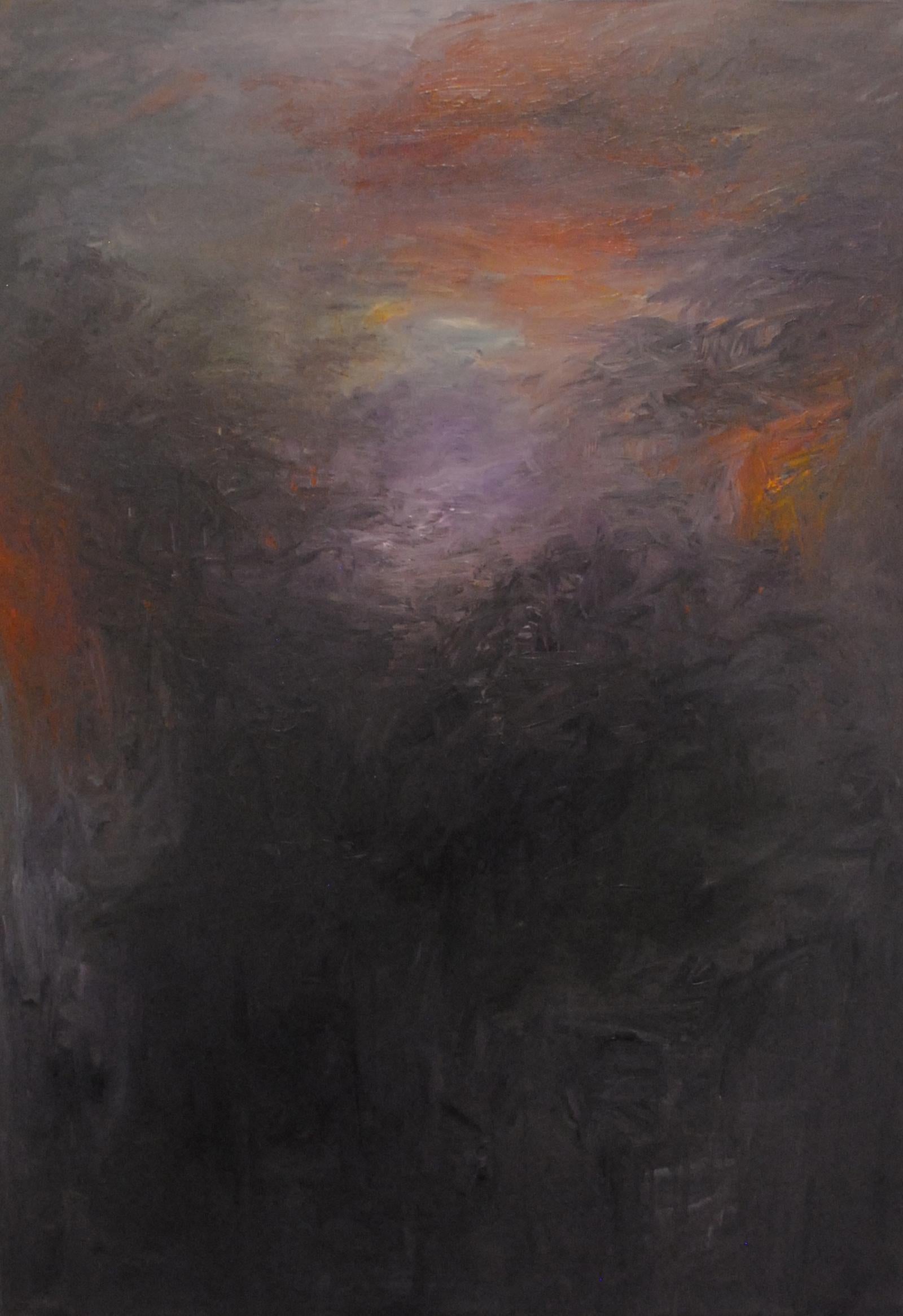James HartmanEncaustic Mountain Landscape, Original Painting2021
2021
About the Item
Artist Comments
A burst of vibrant colors falls on the slopes and trees of this expressionistic landscape. Artist James Hartman layers beeswax over a collage of 100-year-old vintage paper. "I wanted to depict the natural scenery and use color as a way to express the light," shares James. Hints of the collage underneath peek through in some places.
About the Artist
When James Hartman was in art school, he became fascinated with the Society of Six, a group of artists who painted en plein air (outdoors) and exhibited together in the San Francisco Bay Area during the early 20th Century. James's paintings of the Northern California landscape pay tribute to some of the great Bay Area artists of the past. His expressive scenes feel alive through his vibrant use of color and his painterly brushwork. James’s paintings have an immediate visual impact from a distance, yet up close, dissolve into a series of confident marks and strokes. There is a simultaneous complexity and steadiness in his flattened, color-blocked planes. Knowledge and observation are essential elements of James’s working practice. To this end, he spends a large proportion of his time painting on location. His body of work captures the fresh and sunlit essence of the coastal California hills.
Words that describe this painting: expressionism, landscape, trees, encaustic, beeswax, collage, mountains, expressionism, landscape, encaustic artwork, green, yellow
Encaustic Mountain Landscape
James Hartman
Encaustic artwork on wood
Finished black edges
Ready to hang
One-of-a-kind
Signed on back
2021
15.75 in. h x 20 in. w x 1.75 in. d
2 lbs. 12 oz.
- Creator:
- Creation Year:2021
- Dimensions:Height: 15.75 in (40.01 cm)Width: 20 in (50.8 cm)Depth: 1.75 in (4.45 cm)
- Medium:
- Movement & Style:
- Period:
- Condition:Encaustic Mountain Landscape. James Hartman. Encaustic artwork on wood. Finished black edges. Ready to hang. One-of-a-kind. Signed on back.
- Gallery Location:San Francisco, CA
- Reference Number:
James Hartman
California painter James Hartman was born in St. Louis, Missouri, in 1950. He studied art at Meramec College. When Hartman was in art school, he became fascinated with the Society of Six, a group of artists who painted en plein air and exhibited together in the San Francisco Bay Area during the early 20th century. Hartman's paintings of the Northern California landscape pay tribute to some of the great Bay Area artists of the past. His expressive scenes feel alive through his vibrant use of color and his painterly brushwork. Hartman’s paintings have an immediate visual impact from a distance, yet up close, dissolve into a series of confident marks and strokes. Hartman has participated in numerous shows throughout the Bay Area and his paintings are now included in collections both private and corporate internationally.
- ShippingRetrieving quote...Ships From: Medford, MA
- Return PolicyA return for this item may be initiated within 7 days of delivery.
- Edge of the Woods, Original PaintingBy James HartmanLocated in San Francisco, CA
Artist Comments
Artist James Hartman draws inspiration from the experience of seeing sunlit colors and details appearing through the strong vertical tree pattern. He expresses the painting sections to appear like stained glass. James highlights small areas where collaged 100-year-old paper show through the surface, he does this in a non-disruptive way. James applies heat to fuse the oils into a mixture of beeswax and damar crystals to seal the work.About the Artist
When James Hartman was in art school, he became fascinated with the Society of Six, a group of artists who painted en plein air (outdoors) and exhibited together in the San Francisco Bay Area during the early 20th Century. James's paintings of the Northern California landscape pay tribute to some of the great Bay Area artists of the past. His expressive scenes feel alive through his vibrant use of color and his painterly brushwork. James’s paintings have an immediate visual impact from a distance, yet up close, dissolve into a series of confident marks and strokes. There is a simultaneous complexity and steadiness in his flattened, color-blocked planes. Knowledge and observation are essential elements of James’s working practice. To this end, he spends a large proportion of his time painting on location. His body of work captures the fresh and sunlit essence of the coastal California hills.Words that describe this painting: expressionism, encaustic, beeswax, collage, antique ephemera...
Category21st Century and Contemporary Abstract Expressionist More Art
MaterialsEncaustic
- Path to Hidden Beach, Original PaintingBy James HartmanLocated in San Francisco, CA
Artist Comments
Fiery trees tower over a path that opens up to a sparkling hidden beach. Artist James Hartman rendered this piece by first creating his own cradled panel. He ...Category21st Century and Contemporary Abstract Expressionist More Art
MaterialsEncaustic
- A Warm Interior, Original PaintingBy James HartmanLocated in San Francisco, CA
Artist Comments
A warm and vibrant display of orange and yellow flowers in vases, with fruits, cutlery, and wine by artist James Hartman. A painting hangs against the red wall while a view of another room peeks from the left. Part of James' series of interiors using collage, beeswax, and oil paints. "My process is by experiment since the ancient art of encaustics was once lost," shares James. He fuses the pigment into beeswax giving them permanence, preserving the vibrant colors. "I like to begin the process by collaging antique...Category21st Century and Contemporary Abstract Expressionist More Art
MaterialsEncaustic
- Table with Irises, Original PaintingBy James HartmanLocated in San Francisco, CA
Artist Comments
A vibrant encaustic on wood painted with oil over a collage of antique ephemera. Artist James Hartman portrays a colorful still ...Category21st Century and Contemporary Abstract Expressionist More Art
MaterialsEncaustic
- Showoffs, Original PaintingBy Kip DeckerLocated in San Francisco, CA
Artist Comments
Kip Decker paints an expressive arrangement of vibrant red flowers in a vase. The composition emanates an exuberance and joy reaching out to its viewer. Kip thi...Category21st Century and Contemporary Abstract Expressionist More Art
MaterialsAcrylic
- The Ghost Lingers 8, Original PaintingBy Ruth-Anne SiegelLocated in San Francisco, CA
Artist Comments
“A white flower's petals intermingle in a field of deep purple and look like dancers expressing their joy and energy.†says artist Ruth-Anne Siegel. In this expressive floral piece she mixes the colors skillfully for an eye-catching pop. "This painting pairs well with The Ghost Lingers 9."About the Artist
Ruth-Anne Siegel's vibrant floral paintings flow from memory and her love of music. As she works, she references her own photographs and sketchbook, and draws energy from the sounds of Etta James...Category21st Century and Contemporary Abstract Expressionist More Art
MaterialsAcrylic
- Md Tokon - Swim to the End, Painting 2015By Md TokonLocated in Greenwich, CTCollection: Beyond The Horizon Acrylic on canvas Md Tokon's style has reflected the art of American Abstract Expressionists. Md Tokon spent his early years in Jhenidah and Dhaka. Th...Category
2010s Abstract Expressionist Abstract Paintings
MaterialsCanvas, Acrylic Polymer, Cotton Canvas, Acrylic
- Md Tokon - Mountain and Sky, Painting 2014By Md TokonLocated in Greenwich, CTCollection: Earth Acrylic on canvas Md Tokon's style has reflected the art of American Abstract Expressionists. Md Tokon spent his early years in Jhenidah and Dhaka. The physicality...Category
2010s Abstract Expressionist Abstract Paintings
MaterialsCanvas, Acrylic Polymer, Cotton Canvas, Acrylic
- Australian American D. Rankin Abstract Expressionist Oil Painting Rocky HillsideBy David RankinLocated in Surfside, FLDavid Rankin, American (b. 1946) Rocky Hillside, (1990) Oil on paper Hand signed lower right, signed and titled verso. 30 x 22 1/2 inches David Rankin is a New York-based, British-born Australian post-war and contemporary artist known for his expressionistic abstract paintings. His work can be categorized by his use of quick, loose brushstrokes, reminiscent of scribbles on a page. Rankin works predominantly in oil painting and acrylic on canvas, but also works with paper, prints, sculptures and ceramics. Rankin has held over 100 one-person exhibitions in cities across the world, including New York, London, Paris, Beijing, Mexico, Vienna, Berlin and Cologne, as well as all over Australia. Represented in many of the world’s leading public and private collections and museums, David Rankin’s work is featured in Australia’s leading institutions, including the National Gallery of Australia, Art Gallery of New South Wales, National Gallery of Victoria and Queensland Art Gallery. David Rankin was born in Plymouth, Devon, England in 1946 then emigrated to Australia with his family in 1948. He spent his childhood in the 1950s in the semi-rural Port Hacking region South of Sydney and his teenage years in country New South Wales, from Hay, Wagga Wagga and Albury in the South to Bourke and Brewarrina in the North. Rankin is self-taught, developing his techniques and ideas in the outback towns of his youth. He was inspired by the greats from Leonardo da Vinci to Paul Klee as well as being influenced by the history of Buddhism and Asian art. In his travels before he arrived in Sydney in 1967 he developed a concept of what he wanted to achieve as an Australian artist. His dream was to express the anima, the life spirit or the essence of God in all nature. As an Australian artist he believed could bring the elements of Western Art together with an understanding and love for the cultures of Asia and the Australian Aborigine. He also felt that as Australia was closer to Asia than Europe it made sense to think about the art of Indian, Chinese and Japanese artists, and that one could not be an authentic articulate Australian artist without a love and respect for the artistic and spiritual expressions of the various Aboriginal artists, peoples and cultures. His work combined elements of Abstract Expressionist painting with Jewish and Aboriginal influences. In 1979 his first wife, Jennifer Mary Roberts (née Haynes) died. Rankin subsequently met his current wife Lily Brett, whose own life was etched by tragedy with her parents being survivors of the Holocaust. She too migrated to Australia as a child after the Second World War in 1948. The artist recounts that his empathy for Lily and the pity for his first wife's death fused into what he calls "the dark blessing of my life." The darkness was transformed into images. The author Dore Ashton writes that the events of 1979 and the fire which ravished his studio in 1997 and burnt his art works and many personal possessions, had a profound impact on his work. Having personal life experiences as his subject matter, Rankin's paintings contemplate these things. For example, his Jerusalem series followed a trip to Jerusalem in 1988, which then led to his Golgotha works. His travels to the Australian, American and Mexican deserts became the subject matter for many of his canvases, such as Ridge – Mungo, Golden Prophecy – San Antonio, Grey Sonora Landscape and then led to his Witness Series. From the fire in his studio he then painted Buddha and Flames. He illustrated two books by Lily Brett on the holocaust and explored the theme further in his huge work The Drowned and The Saved from a book by Primo Levi of the same name. Through Brett he encountered Jewish mythology and painted judaica imagery, Black...Category
1990s Abstract Expressionist Abstract Paintings
MaterialsPaper, Oil
- Joan Kahn Rome Vibrant Bold Color Abstract Expressionist Modernist Oil PaintingLocated in Surfside, FLOil paint on heavy tar paper. Hand signed and dated verso. Joan Kahn (USA 1953-) grew up in New York City; Princeton, New Jersey; and Vermont; in an envir...Category
1980s Abstract Expressionist Abstract Paintings
MaterialsOil
- Australian Abstract Expressionist Gouache Painting Charcoal on Shaped PaperBy David RankinLocated in Surfside, FLDavid Rankin American (b. 1946) Untitled (Black on gray) (1990) Gouache and charcoal on paper signed lower left 19 x 15 inches Rankin is a New York-based, British-born Australian post-war and contemporary artist known for his expressionistic abstract paintings. His work can be categorized by his use of quick, loose brushstrokes, reminiscent of scribbles on a page. Rankin works predominantly in oil painting and acrylic on canvas, but also works with paper, prints, sculptures and ceramics. Rankin has held over 100 one-person exhibitions in cities across the world, including New York, London, Paris, Beijing, Mexico, Vienna, Berlin and Cologne, as well as all over Australia. Represented in many of the world’s leading public and private collections and museums, David Rankin’s work is featured in Australia’s leading institutions, including the National Gallery of Australia, Art Gallery of New South Wales, National Gallery of Victoria and Queensland Art Gallery. David Rankin was born in Plymouth, Devon, England in 1946 then emigrated to Australia with his family in 1948. He spent his childhood in the 1950s in the semi-rural Port Hacking region South of Sydney and his teenage years in country New South Wales, from Hay, Wagga Wagga and Albury in the South to Bourke and Brewarrina in the North. Rankin is self-taught, developing his techniques and ideas in the outback towns of his youth. He was inspired by the greats from Leonardo da Vinci to Paul Klee as well as being influenced by the history of Buddhism and Asian art. In his travels before he arrived in Sydney in 1967 he developed a concept of what he wanted to achieve as an Australian artist. His dream was to express the anima, the life spirit or the essence of God in all nature. As an Australian artist he believed could bring the elements of Western Art together with an understanding and love for the cultures of Asia and the Australian Aborigine. He also felt that as Australia was closer to Asia than Europe it made sense to think about the art of Indian, Chinese and Japanese artists, and that one could not be an authentic articulate Australian artist without a love and respect for the artistic and spiritual expressions of the various Aboriginal artists, peoples and cultures. His work combined elements of Abstract Expressionist painting with Jewish and Aboriginal influences. In 1979 his first wife, Jennifer Mary Roberts (née Haynes) died. Rankin subsequently met his current wife Lily Brett, whose own life was etched by tragedy with her parents being survivors of the Holocaust. She too migrated to Australia as a child after the Second World War in 1948. The artist recounts that his empathy for Lily and the pity for his first wife's death fused into what he calls "the dark blessing of my life." The darkness was transformed into images. The author Dore Ashton writes that the events of 1979 and the fire which ravished his studio in 1997 and burnt his art works and many personal possessions, had a profound impact on his work. Having personal life experiences as his subject matter, Rankin's paintings contemplate these things. For example, his Jerusalem series followed a trip to Jerusalem in 1988, which then led to his Golgotha works. His travels to the Australian, American and Mexican deserts became the subject matter for many of his canvases, such as Ridge – Mungo, Golden Prophecy – San Antonio, Grey Sonora Landscape and then led to his Witness Series. From the fire in his studio he then painted Buddha and Flames. He illustrated two books by Lily Brett on the holocaust and explored the theme further in his huge work The Drowned and The Saved from a book by Primo Levi of the same name. Through Brett he encountered Jewish mythology and painted judaica imagery, Black Menorah...Category
1990s Abstract Expressionist Abstract Paintings
MaterialsCanvas, Oil
- Large Budd Hopkins Modernist Hard Edged Abstract Expressionist Oil Painting 1965Located in Surfside, FLBudd Hopkins, American (1931-2011) Strike Red Oil on canvas, 1965, signed 'Hopkins' and dated lower right. Dimensions: 85 x81 in., 86 x 52 in. with frame. Provenance: bears partial label remnant verso from Poindexter Gallery. (a major gallery founded in 1955 in New York City by Elinor Poindexter. The gallery specialized in sculpture, abstract, and figurative art and featured the works of such artists as Richard Diebenkorn, Jules Olitski, Nell Blaine, Al Held, Willem de Kooning, Franz Kline, Earl Kerkam, Milton Resnick and Robert De Niro, among others. Budd Hopkins was one of the leading proponents of the "hard-edge" abstract minimalist school of painting in the 1950s and 1960s, Budd Hopkins (born 1931) created works that show the strong influence of Jackson Pollock and other leading painters of the Abstract Expressionism movement. Hopkins' paintings are now in numerous major collections, including the San Francisco Museum of Art, the Guggenheim Museum in New York, and the Hirshhorn Collection in Washington, DC. Recently, he has also been recognized for his research into the matter of UFOs and one of his books, "The Intruders", printed by Random House, was on the New York Times best-seller list and was the basis for a television show on CBS. Born in 1931, he is a graduate of Linsly Military Institute (now Linsly School) in 1949 and Oberlin College in 1953. He first displayed artistic abilities when, as a child recovering from a long-term illness, he began to create sculptures of ships made out of modeling clay. But it wasn't until he arrive at Oberlin that he made a serious study of art. Later, Hopkins included abstracted figures in his sculptural pieces. While moving away from Abstract Expressionism, Hopkins retained in his work the use of intense colors and hard-edged forms. His works of the 1980s, including Temples and Guardians, featured these "sentinels" who were, according to Hopkins, "participating in a frozen ritual, fixed – absolutely – within a privileged space..." Though Hopkins denied any connection, some critics viewed these ritualistic pieces as an extension of Hopkins' fascination with alien beings. Hopkins viewed his sculpted guardians not as human per se, but as magical, fierce, noble robots of the unconscious. He settled in New York after obtaining his degree and has had a residence there ever since. He and his wife, April Kingsley, and their daughter, Grace, divide their time between their home at Cape Cod, Mass., and that in New York City. In his work, he travels widely. He has exhibited in England, Finland, Italy and Switzerland. In 1963, Hopkins was selected by the Columbia Broadcasting System as one of the 15 painters featured in the network's first television special on American art. In 1958, Art News picked him as one of 12 Americans for exhibition in Spoleto, Italy, in the "Festival of Two Worlds." His brilliance has won him a number of fellowships and awards. In 1972, the West Virginia Arts and Humanities Council awarded him its Commission Prize. In 1976, he received the John Simon Guggenheim Fellowship for Painting and in '79 he received a fellowship from the National Endowment of the Arts. He also won a special project grant from the New York State Council on the Arts in 1982. He was friends with Robert Ryman and many of the other 10th street avant garde artists. He was an original member of March Gallery which showed Alice Baber, Elaine de Kooning, Mark di Suvero, Lester Johnson, Matsumi Kanemitsu. His art has been featured in the Metropolitan Museum of Art, Museum of Modern Art, Bronx Museum of Art, Brooklyn Museum, Whitney Museum, Corcoran Gallery, Guggenheim Museum, Queens Museum in New York, and the Public Library of New York. He was included in Young America 1960: Thirty American Painters Under Thirty-Six buy Lloyd Goodrich at the Whitney Museum of American Art in NYC. Artists included: Sonia Gechtoff, Edward Giobbi, Ron Gorchov, James Harvey, Budd Hopkins, Wolf Kahn, Alex Katz, Robert Natkin, Rudy Pozzatti, Dean Richardson...Category
1960s Abstract Expressionist Abstract Paintings
MaterialsPaint






